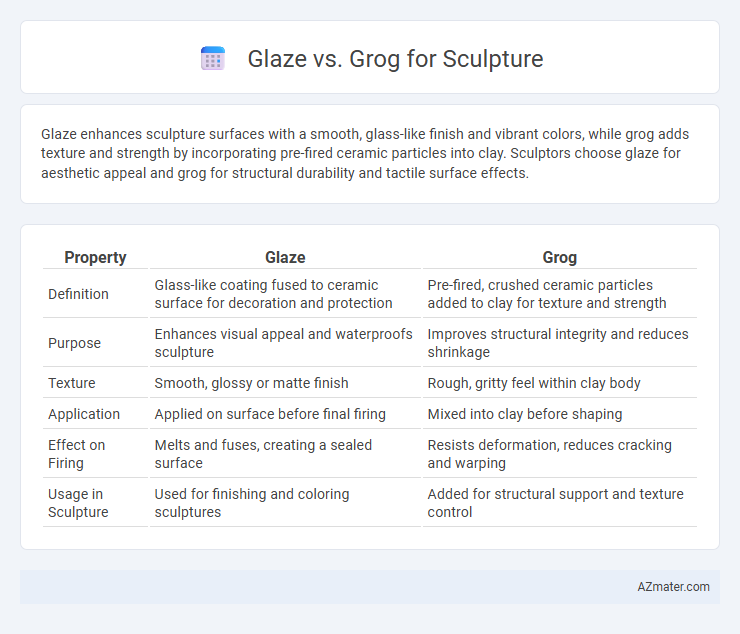Glaze enhances sculpture surfaces with a smooth, glass-like finish and vibrant colors, while grog adds texture and strength by incorporating pre-fired ceramic particles into clay. Sculptors choose glaze for aesthetic appeal and grog for structural durability and tactile surface effects.
Table of Comparison
| Property | Glaze | Grog |
|---|---|---|
| Definition | Glass-like coating fused to ceramic surface for decoration and protection | Pre-fired, crushed ceramic particles added to clay for texture and strength |
| Purpose | Enhances visual appeal and waterproofs sculpture | Improves structural integrity and reduces shrinkage |
| Texture | Smooth, glossy or matte finish | Rough, gritty feel within clay body |
| Application | Applied on surface before final firing | Mixed into clay before shaping |
| Effect on Firing | Melts and fuses, creating a sealed surface | Resists deformation, reduces cracking and warping |
| Usage in Sculpture | Used for finishing and coloring sculptures | Added for structural support and texture control |
Understanding Glaze and Grog: Key Differences
Glaze and grog serve distinct functions in sculpture, with glaze acting as a glassy coating that enhances surface texture, color, and waterproofing, while grog refers to granular, pre-fired clay particles added to clay bodies to improve strength and reduce shrinkage. Glaze chemically fuses to the ceramic surface during firing, creating a smooth or glossy finish, whereas grog physically modifies the clay's structure, increasing its durability and workability. Understanding these key differences helps sculptors select materials that influence both aesthetic qualities and functional performance in their artwork.
Composition and Properties of Glaze
Glaze consists mainly of silica, fluxes, and alumina, forming a glassy surface when fired, which enhances the sculpture's durability and visual appeal with varied textures and colors. Its chemical composition allows it to vitrify, creating a non-porous, often glossy finish that protects the underlying clay body from moisture and wear. Unlike grog, which is composed of pre-fired clay particles added for strength and texture to the clay body itself, glaze modifies the sculpture's surface properties, offering both aesthetic versatility and functional protection.
What is Grog? Functions in Sculpture
Grog is a granular material made from crushed and fired clay added to ceramic clay bodies to improve strength and reduce shrinkage during drying and firing. It functions by increasing the clay's structural integrity, minimizing warping and cracking in sculptures, especially large or intricate pieces. The inclusion of grog enhances texture and provides a more controlled drying and firing process for sculptors.
Surface Effects: Glaze vs Grog
Glaze provides a smooth, glossy surface that enhances color depth and offers a reflective finish, ideal for vibrant and polished sculptures. Grog, consisting of fired clay particles, creates a rough, textured surface that adds tactile interest and structural strength, especially in hand-built or large-scale works. Choosing between glaze and grog depends on the desired surface effect: glazed surfaces emphasize shine and color, while grog emphasizes natural texture and durability.
Working with Glaze: Application Techniques
Working with glaze in sculpture requires precise application techniques such as brushing, dipping, or spraying to achieve uniform coverage and desired texture. Artists must consider glaze viscosity, firing temperature, and compatibility with the clay body to prevent defects like crawling or pinholing. Mastery of layering and controlled drying enhances surface depth and color vibrancy, distinguishing glazed sculptures in both aesthetic and durability.
Sculpting with Grog-Infused Clay Bodies
Sculpting with grog-infused clay bodies enhances structural integrity and reduces shrinkage during firing, making it ideal for large-scale or detailed ceramic sculptures. Grog, composed of pre-fired and ground clay particles, improves workability by adding texture and prevents warping and cracking in the sculpted piece. Compared to glazing, which primarily serves as a surface finish, grog integration directly influences the clay's physical properties, enhancing durability and stability throughout the sculpting process.
Durability and Structural Considerations
Glaze offers a smooth, glass-like surface that enhances sculpture durability by providing resistance to water, chemicals, and wear, making it ideal for both indoor and outdoor displays. Grog, composed of fired clay particles, is added to clay bodies to improve structural integrity by reducing shrinkage and preventing cracking during drying and firing, thus supporting the sculpture's overall strength. Combining grog for internal structural support with glaze for a protective exterior can optimize both the durability and longevity of ceramic sculptures.
Aesthetic Choices: Color, Texture, and Finish
Glaze offers a vibrant color range and a glossy, smooth finish that enhances surface details and provides waterproof protection, making it ideal for sculptures requiring bright, polished aesthetics. Grog, composed of fired clay particles, contributes a rougher texture and matte finish, adding a rustic, tactile quality that emphasizes form and physicality. Choosing between glaze and grog depends on whether the desired sculpture highlights vivid color and sheen or earthy texture and subtle surface variation.
Best Practices for Combining Glaze and Grog
In sculpture, combining glaze and grog enhances both texture and durability, with grog providing structural support and glaze adding a smooth, decorative finish. Best practices include applying grog to the clay body for improved heat resistance and workability while using compatible glaze formulations to prevent crazing or peeling during firing. Controlling firing temperature and cooling rates ensures the glaze bonds well to the grog-infused clay, resulting in a robust and visually appealing sculpture.
Choosing the Right Material for Your Sculpture
Choosing between glaze and grog for sculpture depends on the desired texture and finish; glaze provides a smooth, often glossy surface with color variation, while grog adds coarse texture and structural strength to clay bodies. Sculptors seeking durability and a gritty, tactile feel incorporate grog, which helps prevent cracking during firing and enhances workability. For intricate details and vibrant surface finishes, glaze offers versatility in color and sheen, making it ideal for decorative pieces.

Infographic: Glaze vs Grog for Sculpture
 azmater.com
azmater.com